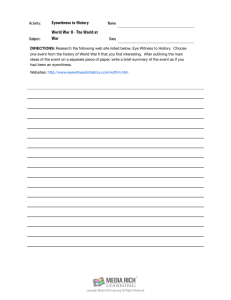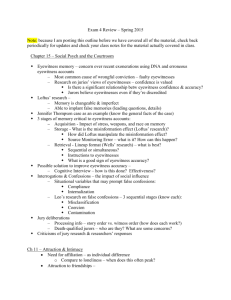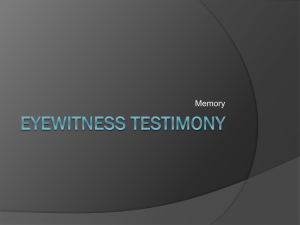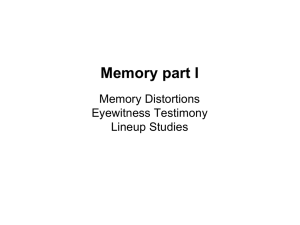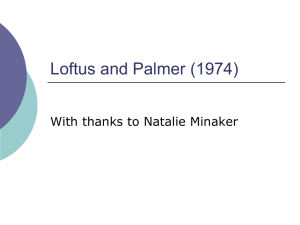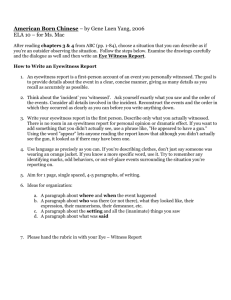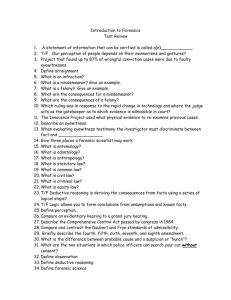Interrogation Tactics Interrogation Tactics: Eyewitness Accuracy as a
advertisement
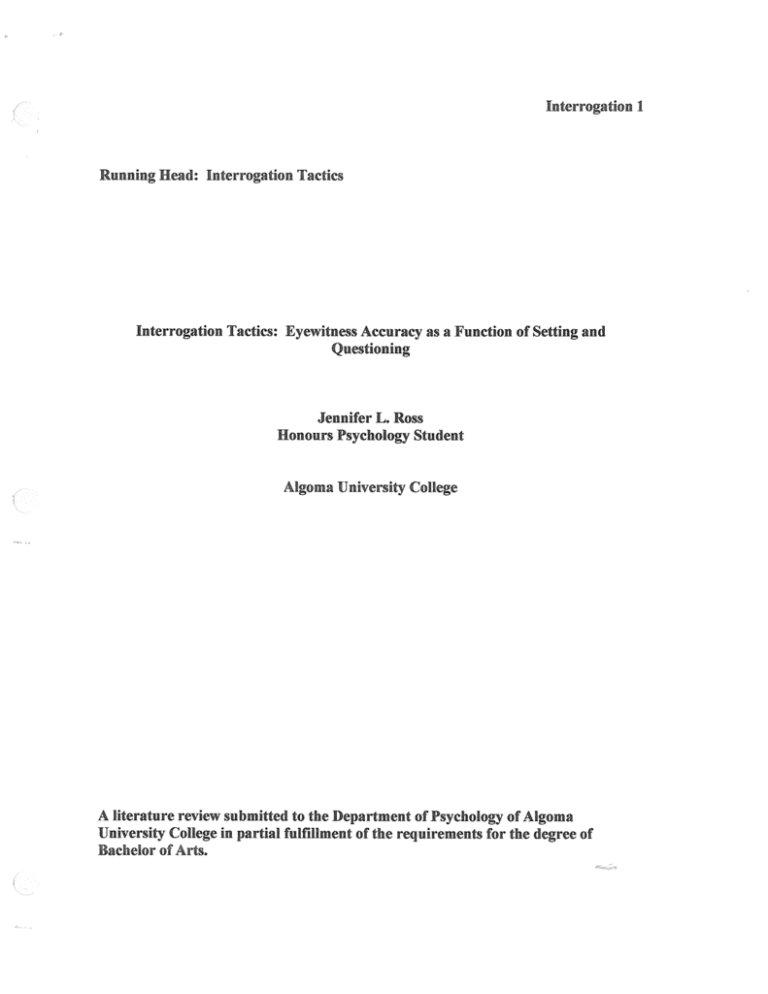
terrogation 1 Running Head: Interrogation Tactics Interrogation Tactics: Eyewitness Accuracy as a Function of Setting and Questioning Jennifer L. Ross Honours Psychology Student Algoma University College A literature review submitted to the Department of Psychology of Algoma University College in partial fulfillment of the requirements for the degree of Bachelor of Arts. Interrogation 2 S'fRACT Is accuracy for eyewitness tes i ony decreased when witnesses are questioned in front of others, rather than privately? Does the presence of others increase the effect of misleading questions? Eyewitness memory is placed as the central theme for recollecting accounts of origin z: events. Inaccuracies and low confidence in the recollections of such events can be directly linked to external cues, such as the presence of others, type of questioning, etc. The paper focuses upon these related factors and proves their importance in eyewitness memory recall. Some of the important research studies stem to include the classics of Loftus (1974) and Asch (1951), and display a connection to more modern research by Roebers (2000) and Winningham (2000). Int.errogation 3 QUESTIONS OF INTEREST? Is accuracy for eyewitness tes ony decreased when witnesses are questioned in front of o+hers, rather than privately? Does the presence of others increase the effect of misleading questions? Memory is a three-stage process that involves witnesses' acquisition, perception of an event, storage or putting away of this information and retrieval of this stored information. In eyewitness testimony certain events can be distorted in such a way that recall may be false. Memory is assisted through various aspects of imagery that include the conscious forms of visual, auditory and somatic sensations, yet these assisting mechanisms may be the most destructive to eyewitness recall. When the mechanisms are manipulated an individual may be a risk of encapsulating the misinformation effect, where the original -event occurrence becomes distorted. There are three major areas of research that are covered within this paper stemming to include: eyewitness testimony and the misinformation effect, eyewitness testimony and confidence and eyewitness testimony and accuracy. Eyewitness Testimony and The Misinformation Effect WHEN PRESENTED WITH MISLEADING INFORMATION about an event they have just witnessed, subjects are likely to claim in numerous memory tests that this misinformation occurred in the original event. Elizabeth Loftus, being a pioneer in the field of eyewitness testimony, demonstrated this effect by the power of the phrasing of a question on witness' reports interrogation 4 of and memory for events. Loftus (1974) showed a short videoclip of a minor car accident, immediately followed by a brief question period to a group of subjects. To half of the subjects she used questioning of the non-leading type to demonstrate its effect. For e.g. Loftus posed a question such as: How fast was the car going when it hit? The neutral words go and hit was used, not to mislead the subjects. The remaining half of the subjects was asked questions of the leading nature that entailed a specific outcome. For e.g. How fast was the car speeding when the car smashed? As demonstrated the words speed and smashed led the subjects to believe that the car was travelling at a high velocity of speed and that the car accident was remembered as being more severe than what was actually depicted on the video-clip. Loftus reached two major fmdings in her research. First it was proven that misleading information affected people's judgements. This can be incorporated into the second major finding that there is evidence of a misinformation effect. The misinformation effect is where people tend to believe that false information as occurring in the original event. The effects of post-event misleading information can distort the memories that individuals possess by altering and adding scenes. Wright (2001) demonstrated this effect through inhibition of recall and recognition of scenes through a series of now you see it and now you don't. Two studies were done involving 268 participants. First participants saw an event consisting of one of two scenarios either a restaurant scene or drunk-driving incident. After a brief time period they were shown the same videoclips again without the critical scene, and were told to do one of two things. For experiment one, the subjects had to create a story. For experiment two, the subjects had to imagine the event. The final test exposed that this post-event omission led to fewer subjects reporting the critical scene in the free recall and recognition. Thus Interrogation 5 demonstrated the effect of inhibition of memory, and how memory is dynamic and occurrences can become altered and sometimes forgotten. Vernon, & Nelson (2000) revealed that through exposure to suggestion the creation of false memories could be created. A short film was viewed by 30 participants, followed by a brief questionnaire Eight of the nine questions were used as filler, while one question asked the participants to recall a phrase that one of the character's in the film had said. Twenty-three of the thirty students reported hearing the main character speak, while simultaneously recalled the exact phrase that he had said. In fact the main character actually said nothing, proving the impact of false auditory memories and illustrating the power of suggestion. Roebers (2000) examined the patterns of the negative impact of misleading post-event information in two different types of eyewitness interviews. Participants ranging in age from six to sixty-four, 284 in total were shown a short videoclip of a theft followed by post-event questioning three and four weeks later. During the three-week question period subjects were either asked open-end and biased questions or misleading and suggestive questions. This was followed by a neutral interview one week later where all subjects were asked recognition questions about the event. Results revealed that regardless of age, all participants exposed to the misinformation effect answered incorrectly and gave false reenactments of what had previously occurred. Later research of Loftus (1979) revealed that memory, unlike a videotape can be altered by the presentation of new information or external cues from the environment. Her study presented participants a short film of an automobile accident, followed by a question period. Her Interrogation 6 participants were divided randomly into two groups. Loftus' first group was asked questions regarding false information pertaining to the film. For instance the participants were asked 'how fast the white sports car was going when it passed the barnyard setting?' in the first group, while the second group was asked the same questions without the mention of the barnyard. There was in fact no barnyard setting present in the film. Loftus' results proved her curiosity of influential questioning, because seventeen percent of the participants in the first group mentioned they had seen a barn in the film compared with a mere three percent in group two. Elizabeth Loftus concluded that the misinformation effect supported her theory that suggestive questioning may alter the outcome of the retrieval of previous eyewitness accounts. Her findings showed that new information through the wording of questions have an extreme influence on the outcome of recall through the replacement of existing information in the memory. More extensive research by Loftus (1996) has shown that there is an increase in the error rate due to the plantation of false memories, or misleading false information. Much like her prior study, the participants were subjected to false memories and questioned based on these false memories. The majority of the participants used in this study reported actually experiencing the false memory. This is much in part due to the type of questioning that was administered, pertaining to the situation. Loftus concluded that multiple choice questions should be avoided. In this way she felt that accuracy and completeness could be encouraged. Eyewitness Testimony and Confidence Shaw, Lafayette, and colleagues (2001) demonstrated the effect of confidence's role in the presence of others. Subjects were shown a short video-clip of a robbery followed by a brief question period to follow concerning the details of what were witnessed in the video. Subjects Er rogation 7 were placed into groups of 4 or 5 where they were labeled as being in the private group or the public group. Those that were randomly assigned into the public group were asked to share their answers about the details of the video aloud to the group along with their confidence ratings. The remaining half of the subjects or private groups was told to keep their answers to themselves along with their confidence ratings. As predicted confidence ratings were reportedly lower in the public condition than in the private condition. However the privacy condition had no effect on response accuracy. The most significant set of debating factors falls within the relationship of accuracy and confidence. Kebbell and Wagstaff (1996) examined the confidence levels of witnesses. Their research revealed that a witness's degree of certainty is quite malleable and can be easily inflated. It was found that the confidence levels could be influenced by external factors that have nothing to do with the witness's actual memories or perceptions of an event. In their research they staged a theft for pairs of eyewitnesses, then separately asked each of them to identify the "thief' in a photo lineup. After the identification process, some of the witnesses were told that their partner had identified the same suspect and the levels of confidence increased drastically. Witnesses who were told their co-witness either identified someone else or made no identification expressed less confidence. Another interesting aspect that was realized was that when the witnesses were subsequently told about their previous misinformation regarding their co-witness statements, their confidence levels did not return to their original level. Their research was concluded with a final thought regarding an eyewitness's confidence that the level should be recorded when the identification is first made and that many outside influences may affect one's confidence level. This may stem from the prospect that people tend to strive for peer acceptance no matter the race, age, or gender. Interrogation 8 In keeping with this, research proved there was a significant finding of the roles of accuracy and confidence in the presence of an emotional event. Garcia (1999) reported the effect of eyewitness memory in an emotional event Vs neutral event. Garcia portrayed an emotional event (argument) or a neutral event through a live classroom interruption. A total of 44 subjects participated in this event being either exposed to one of the two stimuli. Results reveal that subjects in the emotional group recalled and recognized more verbal and visual information, more verbal and visual actions, and more verbal actions than verbal details. Subjects in the emotional group had overall better recall, recognition, and confidence than subjects exposed to the neutral event. Presence of Others — Impact on Accuracy Asch (1951) had confederates give incorrect answers in a task on which the lengths of two line segments were compared. Subjects were influenced by the responses made by the confederates. They gave false answers, which conformed with to the answers given by the confederates. The main result that Asch discovered was the people tend to conform with the majority because of the strive for peer acceptance and influence regardless of the consequence. People can be falsely encouraged or led to believe that something occurred or is correct when it in facet is incorrect. Much like the research of Loftus, Asch looked at the effect of leading information on judgements. Asch's research revealed the social impact of others on accuracy of responses and raises the question of whether there is a link of confidence as a factor or impact on the way an individual responds. Interrogation 9 Hoffman (2001) used a modified version of Asch's classic (1951) conformity paradigm that studied the impact of social influence on reality monitoring decisions about new items presented. In Hoffman's study subjects studied pictures of some objects while imagined others. In a post-event test stage the subject's were asked to judge items as either been imagined, or were new. For some of the items the subjects were informed of a confederate's response before giving a judgement. Winningham (2000) investigated the effects of pressure to report more details on memories of an eyewitness event. Subjects in this study witnessed a staged event and were questioned up to 5 times about that particular event. Some of the subjects were pressured to report more details than others. Results showed that pressuring subjects to report more details increased the number of accurate and inaccurate statements. The main effect found was that pressuring subjects to report more details did not change the how confident they felt about how accurate they answered. Wright (2000) revealed that post-event information could affect people's memory reports when delivered by another person through two unique experiments. For the first experiment, a total of 40 subjects were shown a series of cars, followed by an 'old/new' recognition test on the cars. The 'old/new' recognition test was done in small groupings of two. There was a small finding of the effect of memory conformity where the participants were given misinfonnation, lowering their accuracy, while presentation of accurate infonnation increased the accuracy reporting. In a second experiment 40 participants, in pairs, viewed an identical crime where one individual saw an accomplice with the thief while the other individual did not. It was reported that the initial memory recognition was correct, yet after the discussion of what they had saw, recognition became flawed. The majority of the pairs conformed and confidence ratings significantly predicted which person in the pair persuaded the other. Interrogation 10 Wright (1997) showed First year psychology students a video-clip of Robocop, followed by a completely off topic lesson plan. Twenty-four hours later the subjects filled out a questionnaire regarding the movie. Most of the students answered more than half of the items correctly. The mean number correct was 9.60 items correct out of 14 questions. Many of the questions on the quiz were based on peripheral details about the crime scene. In support of these criteria, another research study conducted by Cutler, Penrod, and Martens (1987), peripheral details were found to be the most emphasizing due to their relation to identification accuracy in eyewitness testimonials. Students were bewildered at the average, feeling the number should be higher and were skeptical to some detail. If this were the case the clip was shown again to point out the details that were overlooked. This was then contrasted to be compared to a real life setting and the discussion of the reality of eyewitness identification. Also it was noted that both of the scenarios were conducted in such a manner that none of the participants had any knowledge to their participation in such research pertaining to the topic of eyewitness testimony prior to the video-clip, scenario, or evaluation afterward. Placement into at-risk situations is used to predict identification accuracy. There are several ways to demonstrate memory for witness events, through re-enactment of a staged event to captivate the audience's reactions, where the actors proceed to interrupt the class and students attempted to identify that person. This was demonstrated by Luus and Well (1994); Moye and Yarbrough (1992) where their main priority was to determine the number of correct identifications while putting the students in an unexpected state of mind or stressful manner. This demonstration has proven effective yet raises ethical concerns for the safety of traumatic or emotional states that may take rise due to the student's interference to stop the staged crime. The mean average reported by one particular experiment was five point nine on a likert Interrogation 11 seven-point scale. However the creation and distribution of videotape were deemed as just as reliable as a staged event in terms of distinguishing the individual differences that exist in terms of accurate identification processes. This was administered and scored through the process of a questionnaire that consisted of multiple choice/true-false questions. One specific experiment proves the efficiency of such testing in terms of video-clip and questionnaire Support of this particular experiment also includes the study by Christianson (1992), who believed that some conditions of stress seem to produce external loci of control and a type of focus which actually make for better, not worse accuracy and recall. Life events accompanied by strong negative affect or emotion are remembered with greater difficulty than events accompanied by less intensity, or valence of the effect. There appears to be a curvilinear or Yerkes-Dodson relationship between emotion and recall. Recovered memories of negativity may be developed, yet attitudes toward the memory tend to remain consistent regardless of the outcome of truth or when faced with the distinction of false beliefs. To the contrary, Christianson (1992) believed that overall there was little reason to believe in the Yerkes-Dodson law since it has been so extensively critiqued regarding eyewitness applications and may appear to be unwarranted in some cases. Other accuracy errors may be the direct result of psychological trauma or shock experienced by the eyewitness. The weapon-focus effect is on of these factors that may influence the falsifiability of prior events. Research shows that when a suspect pulls out a gun, razor blade, or knife, witnesses are less likely to identify the culprit than if no weapon is present (Steblay, 1992). According to an experiment that involved showing subjects slides of a customer walking up to a bank teller and pulled out an unidentified object that was either a gun or a checkbook. The eye movements of those involved in the study were recorded period that consisted of thirty- Interrogation 12 two open-ended questions about the film Results show that recall and confidence in recall accuracy was low and that recall accuracy is reportedly better for central action details than peripheral. There was no statistical significance was revealed concerning the recall of descriptive details related to peripheral or central actions. CONCLUSION Is accuracy for eyewitness tes ony decreased when witnesses are questioned in front of others, rather privately? Does the presence of others increase the effect cf misleading questions? Through the research the following questions of interest have been primarily investigated and some evidence or link has been established. For instance research concerning the misinformation effect proved helpful and found to have repetitive accurate outcomes. The impact of confidence in the presence of others had a positive correlation, yet accurate responses in the presence of others still remains questionable. Much of the literature tends to support the question of whether external factors contribute with false memory recall. Overall it can be stated that the mind is a powerful mechanism that tends to illustrate and captivate what it perceives to be true based on the external encounters or cues resulting in wrongful convictions, and inaccuracies in reporting of details and confidence. Interrogation 13 Rii,-4 FERENCES -1 Asch, S. E. (1951). Effects of group pressure upon the modification and distortion of judgements. H. Guetzkow (Ed.) Groups leadership and men: Research in human Relations (177-190). Pittsburgh: Carnegie Press Cutler, B. L., Penrod, S. D., & Martens, T. K. (1987). The reliability of euyewitness identification. Law and Human Behaviour, 11, 233-258. Garcia, B. E., & Migueles, M. (1999). Eyewitness Testimony in an emotional Vs neutral event. Psicologica, 20(2), 91-102. Hoffman, H. G. & Granhag, P. A. (2001). Social Influences on relaity-monitoring decisions. Memory and Cognition, 29, 394-404. Kebbell, M. R., & Wagstaff, G. F. (1996). The influence of Item Difficulty on the Relationship Between Eyewitness Confidence and Accuracy. British Journal of Psychology, 87, 653-663. Lindholm, T., & Christianson, S-A. (1992). Intergroup Biases and Eyewitness Testimony. Journal of Social Psychology, 138, 710-724. Loftus, Elizabeth. (1974). Reconstructing memory: The incredible eyewitness. Psychology Today, 87, 116-119. Loftus, E. F. 91979). Leading questions and eyewitness report. Cognitive Psychology, 7, 560572. Luus, C. A. E., Wells, G. L. (1994). The malleability for eyewitness confidence: Co-witness and perserverence effects. Journal of Applied Psychology, 79, 714-723. Moye, T., Yarbrough, N. (1992). Wortman/Lofius Psychology (4 th ed). New York: McGrawHill. Interrogation 14 Roebers, C. M., & Schneider, W. (2001). Memory for an observed event in the presence of prior misinformation: Developmental patterns of free recall and identification accuracy. British Journal of Developmental Psychology, 19(4), 507-524. Shaw, John S., Lafayette Coll, Zen, Tana K., Woyathler, Keith A. (2001). Public Eyewitness Confidence Ratings can differ from those held privately. Law & Human Behavior, 25, 141-154. Steblay, N. M. (1992). A meta-analytic review of weapon-focus effect. Law and Human Behaviour, 16, 413-424. Vernon, B. & Nelson, E. (2000). Exposure to suggestion and creation of false auditory memories. Psychological Reports, 86, 344-346. Winningham, R. G., Weaver, C. A. (2000). The Effects of Pressure to Report more Details on Memories of an Eyewitness Event. European Journal of Cognitive Psychology, 12, 271282. Wright, D. B. & Loftus, E. F., & Hall, M. (2001). Now you see it; now you don't: Inhibiting recall and recognition of scenes. Applied Cognitive Psychology, 15(5), 471-482. Wright, D. B., & Self, G. &, Justice, C. (2000). Memory conformity: Exploring misinformation effects when presented by another person. British Journal of Psychology, 91, 189-203. Yerkes, R., Dodson, J. (1908). The relation of the strength of a stimulus to rapidity of habitinformation. Journal of Comparitive Neurology and Psychology, 18, 459-482. thesis.sav settingq 1.00 typeques 1.00 1.00 1.00 1.00 1.00 1.00 1.00 1.00 1.00 1.00 1.00 1.00 1.00 1.00 1.00 1.00 1.00 1.00 13 1.00 1.00 1.00 1.00 14 15 16 17 1.00 1.00 1.00 1.00 18 19 1.00 1.00 1.00 1 2 3 4 5 6 7 8 9 10 11 12 20 21 22 23 24 25 26 27 28 29 30 31 32 33 34 35 04/24/03 10:27:42 PM 2.00 2.00 2.00 2.00 accuracy 10.00 9.00 confiden 27.00 10.00 9.00 12.00 28.00 30.00 29.00 6.00 13.00 10.00 9.00 27.00 26.00 27.00 29.00 10.00 9.00 33.00 28.00 27.00 13.00 11.00 14.00 7.00 10.00 2.00 2.00 2.00 12.00 2.00 2.00 2.00 2.00 1.00 12.00 13.00 12.00 14.00 2.00 2.00 2.00 2.00 1.00 1.00 1.00 1.00 13.00 13.00 12.00 2.00 2.00 2.00 1.00 1.00 1.00 2.00 1.00 1.00 18.00 2.00 2.00 2.00 13.00 13.00 15.00 2.00 2.00 15.00 14.00 2.00 2.00 2.00 2.00 2.00 2.00 9.00 10.00 9.00 13.00 14.00 26.00 33.00 33.00 22.00 34.00 31.00 33.00 36.00 27.00 41.00 37.00 35.00 41.00 37.00 36.00 30.00 34.00 40.00 39.00 40.00 40.00 33.00 37.00 33.00 1/2 thesis. say 36 37 38 39 40 04/24/03 10:27:42 PM settingq 2.00 2.00 2.00 2.00 2.00 typeques 2.00 2.00 2.00 2.00 2.00 accuracy 10.00 13.00 14.00 14.00 14.00 confiden 32.00 33.00 38.00 38.00 36.00 2/2 Univari:t1 Analysis of Variance Eatween-Subjects Factors SETTINGQ 1.00 2.00 TYPEQUES 1.00 2.00 Value Label Public Private Non-Leading Leading 20 20 20 20 Descriptive Statistics Dependent Variable: ACCURACY SETTINGQ Public Private Total Std. Deviation 1.87380 2.11082 2.08945 2.71825 1.43372 2.17643 2.66112 2.08756 2.44412 Mean 9.8000 11.3000 10.5500 12.5000 13.5000 13.0000 11.1500 12.4000 11.7750 TYPEQUES Non-Leading Leading Total Non-Leading Leading Total Non-Leading Leading Total N 10 10 20 10 10 20 20 20 40 Tests of Between-Subjects Effects Dependent Variable: ACCURACY Source Corrected Model Intercept SETTINGQ TYPEQUES SETTINGQ * TYPEQUES Error Total Corrected Total Type III Sum of Squares 76.275a 5546.025 60.025 15.625 1 Mean Square 25.425 5546.025 60.025 15.625 5.841 1274.135 13.790 3.590 Sig. .002 .000 .001 .066 .625 1 .625 .144 .707 156.700 5779.000 232.975 36 40 39 4.353 df 3 F a. R Squared = .327 (Adjusted R Squared = .271) Urnivariate _nalysis of V.___lance Between-Subjects Factors SETTINGQ 1.00 2.00 TYPEQUES 1.00 2.00 Value Label Public Private N 20 20 Non-Leading 20 Leading 20 Page 1 Descriptive Statistics Dependent Variable: CONFIDEN SETTINGQ Public Private Total Mean 28.2000 30.4000 29.3000 37.0000 36.0000 36.5000 32.6000 33.2000 32.9000 TYPEQUES Non-Leading Leading Total Non-Leading Leading Total Non-Leading Leading Total N Std. Deviation 2.14994 4.27395 3.48077 3.46410 3.05505 3.22000 5.31532 4.61804 4.92404 10 10 20 10 10 20 20 20 40 Tests of Between-Subjects Effects Dependent Variable: CONFIDEN Source Corrected Model Intercept SETTINGQ TYPEQUES SETTINGQ * TYPEQUES Error Total Corrected Total Type III Sum of Squares 547.600a 43296.400 518.400 3.600 df F 3 1 1 1 Mean Square 182.533 43296.400 518.400 3.600 16.511 3916.257 46.890 .326 Sig. .000 .000 .000 .572 25.600 1 25.600 2.316 .137 398.000 44242.000 945.600 36 40 39 11.056 a. R Squared = .579 (Adjusted R Squared = .544) Page 2 Interrogation 1 Running Head: Interrogation Tactics Interrogation Tactics: Eyewitness Accuracy as a Function of Setting and Questioning Jennifer L. Ross Honours Psychology Student Algoma University College A thesis submitted to the Department of Psychology of Algoma University College in partial fulfillment of the requirements for the degree of Bachelor of Arts. Interrogation 2 ABST CT. Is accuracy of eyewitness testimony decreased when witnesses are questioned in front of others, rather than privately? Does the presence of others impact the effect of misleading questions? First year university students (N=40) viewed a videotaped murder scene and then answered leading or non-leading questions privately or in front of 3 confederates who had viewed the same video and were potentially able to contradict the answers. As predicted, accuracy was significantly lower in the publicanswering group (F=(1, 36) = 13.790, p<. 001). However, no significant differences were observed for question type (F=(1, 36) = 3.59, n.s.), and there was no interaction between question type and setting (F (1, 36) = .144, n.s.). Interrogation 3 This : .:.zrsonal account is the idea 77.1hin . - sri concept for my thesis idea. THE SCENARIO: One male and two females entered a clothing tore and prc xed( 1 to try or nd buy almost everything in sight. They L 1 21 - - -- - - with a credit card and left. The next day the employees rind out that the card Cal .vas used was actuality s: - - The owner of the credit card was an elderly man who was beaten upon taking Lis wallet. Two caployees were told they were going to be questioned by a deect:ve - remember the eltaills of the event. They were interrogated 'In one of two different settings, alone and in front of others. V [ ?rson interrogated - - in frc_i of tL group felt very anxious and &filet: to recall the details expressing low confidence. That e__ ployee wondered iLia: the others were thinking, and was embary }seC hat they did not Csa-ss of the incident to submit the sante story. By now it was too late, the details i fere colleCed, and many unanswered c -tstions arose. -- Interrogation 4 QUESTIONS OF INTEMEST? Is accuracy of eyewitness est )ny decreased when witnesses are questioned in LILO of others, r "Der than privately? - Does the presence of c_:_zrs increase the effect GI ;;, „isleading questL.--s? - Interrogation 5 INTRODUCTION WHEN PRESENTED WITH MISLEADING INFORMATION about an event they have just witnessed, subjects are likely to claim in numerous memory tests that this misinformation occurred in the original event. Elizabeth Loftus, being a pioneer in the field of eyewitness testimony, demonstrated this effect by the power of the phrasing of a question on witness' reports of and memoiy for events. Loftus (1974) showed a short videoclip of a minor car accident, immediately followed by a brief question period to a group of participants. To half of the participants she used questioning of the non-leading type to demonstrate its effect. For e.g. Loftus posed a question such as: How fast was the car going when it hit? The neutral words go and hit were used, not to mislead the subjects. The remaining half of the participants were asked questions of the leading nature that entailed a specific outcome. For e.g. How fast was the car speeding when the car smashed? As demonstrated the words speed and smashed led the subjects to believe that the car was travelling at a high velocity of speed and that the car accident was remembered as being more severe than what was actually depicted on the videotape. Loftus reached two major fmdings in her research. First it was proven that misleading information affected people's judgements. This can be incorporated into the second major finding that there was evidence of a misinformation effect. The misinformation effect is where people tend to believe that false information occurred in the original event. Loftus concluded that memory is unlike a videotape, that it is dynamic and can be readily altered. Loftus' work fit well with early research reported by Asch. Asch (1951) had confederates give incorrect answers in a task on which the lengths of two line segments were Interrogation 6 compared. Participants were influenced by the responses made by three confederates. They gave false answers, which conformed with the answers given by the confederates. The main result that Asch discovered was that people tend to confaiin with the majority because of the strive for peer acceptance and influence regardless of the consequence. People can be falsely encouraged or led to believe that something occurred or is correct when it in fact it is incorrect. Much like the research of Loftus, Asch portrayed the effect of leading information on judgements in his classic study. Asch's research not only revealed the social impact of others on accuracy of responding, yet raised the question of whether there was a link of confidence a major impact on the way one responds. Shaw, Lafayette, and colleagues (2001) demonstrated the effect of an individual's confidence for accuracy recall in the presence of others. Participants were shown a short videoclip of a robbery, followed by a brief question period that concerned the details of what was witnessed in the video. Participants were placed into groups of 4 or 5 where they were labeled as being in the private group or the public group. Those whom were randomly assigned into the public group were asked to share their answers about the details of the video aloud to the group along with their confidence ratings. The remaining half of the subjects or private groups were told to keep their answers to themselves along with their confidence ratings. As predicted confidence ratings were reportedly lower in the public condition than in the private condition. However the privacy condition had no effect on response accuracy. QUESTIONS OF INTE ST? Is accuracy of eyewitness testimony decreased when witnesses are questioned in front of (Alias, rather than privately? Does the presence of others increase the effect of misleading questions? Interrogation 7 METHOD PALITECIPANTS. The subjects in this study were male and female undergraduate students enrolled at Algoma University College. A total of forty students participated in this study. The majority of the students were given a percentage credit for their participation. TE LS. The materials needed for the demonstration included a videotape copy of Anatomy that can be rented at any video store; a 12-question quiz based on the details of the videoclip, and the memory distracter task. The videotape clip that was chosen portrayed a murder scene. The videoclip started 18:10 from the beginning of the movie and lasted approximately 7 minutes in duration. Anatomy was used because of the unfamiliarity of the actors and the setting, being they were both of German descent. The 12 questions consisted of 10 multiple choice questions and 2 short answer. Following each of the multiple-choice questions was a short confidence rating scale. The subjects had to rate how confident they were in their answers on a five-point scale. (1= very confident, 3 =50/50, 5= very unconfident) There were two versions of the quiz question type: Non-leading or Leading. A sample question that was used for both versions was: Type of Question: Non-Leading How many drinks did the waitress bring to the table? Type of Question: Leading How many drinks did the waitress struggle to bring to tLe table? ',errogation 8 A distracter task was used in the time interval that followed the videoclip and prior to the question period. The distracter task consisted of three logical reasoning style questions. A distracter task was used to prevent any socializing between the participants and to take the focus away from the eyewitnessed event. The memory activity tasks can be obtained from the following website: http://teach-nology.com/worksheets/critici*_ hinking/logic/12/ Sample Question: The Hotel Three people check into a hotel. They pay $30 to the manager and go to their room. The manager finds out that the room rate is $25 and gives $5 to the bellboy to return. On the way to the room the bellboy reasons that $5 would be difficult to share among three people so he pockets $2 and gives $1 to each person. Now each person paid $10 and got back $1. So they paid $9 each totaling $27. The bellboy has $2, totaling $29. Where's the remaining dollar? EXPE I ENTAL DESIGN: The type of design used was a 2X2 between group design. Two independent variables were manipulated each having two levels and a total of four corresponding conditions. Type of Questioning (Non-Leading or Leading) X Setting of Questioning (Private or Public) TYPE OF QUESTIONING Non-Leading Public TYPE OF SETTING Private (alone) Leading Interrogation 9 PROCEDURE In a group total of five, students entered a secluded room located in Portable 3 at Algoma University. Three of the students were upper year or graduating students that were posing as participants, having knowledge of the experiment. The remaining two participants were introductory year students that were the true subjects in the experiment. They were seated in one of five chairs that directly faced a media center that consisted of a television and a VCR. A memory task was handed to them that consisted of a total of three questions: They were to answer the questions alone and without any help from the others. This was handed into the experimenter for evaluation, while she told the group to watch the contents of a brief video-clip. While the movie played the experimenter left the room to avoid any disruption and returned when it was complete. A distracter memory task was handed to the group. Upon completion of the distracter task the results of the memory test from the beginning of the experiment were revealed. Up until this point all true subjects were treated identically. TYPE OF QUESTIONING Non-Leading Public TYPE OF SETTING Private Leading Interrogation 10 Half of the true participants were randomly assigned to the Private Condition. In this circumstance, one of the two true participants was taken into the hallway and told to wait there. Momentarily another confederate led them down the hall into a room that contained a computer, a desk, and a chair The participant was instructed to sit down and to answer the following questions that pertained to the video-clip that they had previously watched. Meanwhile, the remaining half of the true participants were randomly assigned to the Public Condition. A participant assigned to this condition was told to sit in a chair at the front of the room, in front of the other three confederates. The media center that once consisted of a television and VCR, now was a computer center. The pal ticipant was told to read the instructions aloud to the group. The instructions stated that they (the true participant) had been chosen to represent the remainder of the group (3 posing participants) and that they were to answer the questions accurately and efficiently, yet on behalf of the group with no help from the group. They were chosen because they were told they received the highest score on the memory test at the beginning of the experiment. The only catch was that they were in fact not chosen for this reason but because they were a true subject and that their fate was determined due to their pad ticipation. They too answered questions of either the leading type or the non-leading type. During this question period the role of the confederates was to remain silent, but to stare at the participant and peer over their shoulder. Although the computer screen was extremely vivid because of the large font and the answers were made evident to the group. Immediately following this, the true subjects were asked to fill out a three-question manipulation check, to determine whether performance anxiety was a factor in the public condition. Debriefing was done in some cases that were necessary through a brief explanation of the experiment, and peer counseling. Interrogation 11 RESULTS & DISCUSSION The questions consisted of 10 multiple choice questions and 2 short answer questions and were scored out of a possibility of 20 points. One point was allotted per correct multiple-choice question. Five points per short answer question were allotted for answering the correct details of what the subjects had eyewitnessed. The means are displayed for the four conditions as follows: Results for Accuracy: TYPE OF QUESTIONING Non-Leading Public 9.8 Leading 11.3 TYPE OF SETTING Private 12.5 13.5 There was a significant effect of the type of setting and the accuracy of answering details. F((1, 36) = 13.790, p(.001.) The public setting proved to be the less effective for accuracy of responses (mean = 10.55), while the private setting (mean = 13.00) proved to be the most effective setting for remembering the details of the murder scene. Interrogation 12 There was no significant reported interaction between setting type and type of questioning used. F((1, 36) = .144, n.s.). Results: Question Type: Non-Leading VS Leading There was no significant reported effect of question type on the accuracy of details. F((1, 36) = 3.590, n.s.). There was no significance reported in my study between non-leading and leading questions. According to Elizabeth Loftus there is a definite effect of misinformation or the use of misleading words as opposed to neutral words that captivate the eyewitness into believing false accounts of the original event. (Loftus, 19) However in my study I used leading words to direct toward the correct answer. I helped the subjects achieve the correct answers. For example the previous example in the leading question type: How many drinks did the waitress struggle to bring to the table? a) 4 b) 6 c) 8 d) 5 The subjects were more likely to respond to the answer C that was actually the correct answer. The word struggle implied that the waitress had a hard time carrying the chinks to the table implying that she was carrying more as opposed to less. Interrogation 13 RESULTS: COI1FIDENCE TYPE OF QUESTIONING Non-Leading 28.2 Public Leading 30.4 Type of Setting Private 37.0 36.0 There was a significant difference in the type of setting and the outcome of the subject's confidence levels. F((1, 36) = 46.890, p,.001) There was a significant effect reported of high levels of confidence reported in the private setting for both types of questions (mean = 36.5) as opposed the public setting for both types of questions (mean = 29.3). There was no reported significance of question type on subject's confidence levels. F(1, 36) = .326, n.s.) There was no reported significant interaction between setting type and question type on a participant's reported confidence. F((1, 36) = 2.316, n.s.) It can be said that overall there was a main effect of the private setting on accuracy of detail recall, which can be said to be linked to confidence of the individual. The type of setting explained 27% of the change in accuracy. Also leading questions can increase the number of Interrogation 14 responses that a subject reports, but because leading information can be accurate, misleading effects on accuracy can vary. Interrogation 15 OUTPUT FOR DEPENDENT VARIABLE: ACCURACY OF DETAILS Dependent Variable: ACCURACY SETTINGQ TYPEQUES Me Public Non-Leading 9.8000 Leading 11.3000 Total 10.5500 Private Non-Leading J 12.5000 Leading 13.5000 Total 13.0000 I Total Non-Leading 1 11.1500 Leading I 12.4000 Total 11.7750 Std. Deviation 1.87380 2.11082 2.08945 2.71825 1.43372 2.17643 2.66112 2.08756 2.44412 101 10 I 20 I 20 20 40 Tests of Between-Svhjects,Effects Dependent Variable: ACCURACY Source Corrected Model I Intercept SETTINGQ I TYPEQUES I SE I I INGQ TYPEQUES Error Total Corrected Total ype ill Sum of Squares 76.275a 5546.025 60.025 15.625 .625 156.700 5779.000 232.975 df 3 1 36 40 39 a. R Squared = :327 (Adjusted R Squared = .271) Mean Square 25.425 5546.025 60.025 15.625 .625 4.353 F 5.841 I 274.135 I 13.790 i 3.590 I .144 Sig. .002 .000 1 .001 .066 .707 interro _ OUTPUT FOR DEPENDENT VARIABLE: CONFIDENCE SETTINGQ T'PE QUES ii Mean Non-L Std. Deviati on 2:14994 Leading Total . 30400.0 427395 29.3000 3.48077 Non-Leading Leading_ 37.0000 36.0000 146410 3.05505 10 Total _36_5000 Non-Leading I 32_6000_ Leading 33.2000 _3_22000 20 .1 Total 20 5_31532_ 4.61804 32.9000 201 40 4.92404 Tests of Between-Subjects Effects Dependent Variable: CONFIDEN _Source. Corrected Model - 1_Intercept SETTINGQ TYPEQUES SETTINGQ `"' TYPEQUES Error i Total Corrected Total Type ii Sum of S uares 547.60081 df Mean Square 3 43296.400 1 182.533 43296.400 518.4001 1 518.400 j 3.600 j 1 3.600 1 25.6001 11.056 25.600 398.000 44242.000 j 1 945.600 1 36 40 39 a. R Squared = .579 (Adjusted R Squared = .544) F 16.511 3916.257 Sig_ .000 .000 46.890 .000 1 .326 .572 1 2.316 .137 Interrogation 17 DIE CUSSION This experiment replicated the effect reported by (Loftus, 1974) using a video-clip to depict events rather than a slide show. In keeping with this subjects that were exposed to the misinformation following the main event were more likely than non-exposed subjects to claim that they have seen the misinformation as part of the target event. The finding was replicated using a more modem method. Although the experiment did not replicate the exact findings as the Loftus study of 1974, where suggestive questioning mislead the subjects to select the inaccurate responses. This study did in fact demonstrate the misleading effect's power of suggestion and how it can lead someone to state a response through the presence of an external cue, whether that be auditory, visual or simply through the presence of others. The experiment did achieve the desired effect and answered the question as to whether or not other people impacted the way one answered and how confident they were in their answers. As the research suggested many studies have replicated the effect and found no statistical findings pertaining to accuracy and setting type. However this research has proven that it is possible when an individual is answering on behalf of a group or when there is incentive involved as opposed to the stakes being lowered. Studies have shown that there is indeed a huge impact on confidence levels being lowered in the presence of others. In this experiment as stated this finding has been indeed replicated to prove this to be indeed true. Interrogation 18 The research project showed that upper year students had an impact on introductory year students, and women intimidated men based on the reports of the manipulation check. It has been suggested that the social impact of authority figures or adults claiming the roles of the confederates may have taken a intimidation stand or have a greater influence on the participants. Future research in this area of study could take this idea into consideration. Interrogation 19 REFERENCES Asch, S. E. (1951). Effects of group pressure upon the modification and distortion of judgements. H. Guetzkow (Ed.) Groups leadership and men: Research in human Relations (177-190). Pittsburgh . Carnegie Press - Loftus, Elizabeth. (1974). Reconstructing memory: The incredible eyewitness. Psychology Today, 87, 116-119. Shaw, John S., Lafayette Coll, Zen, Tana K., Woyathler, Keith A. (2001). Public Eyewitness Confidence Ratings can differ from those held privately. Law & Human Behavior, 25, 141-154.
